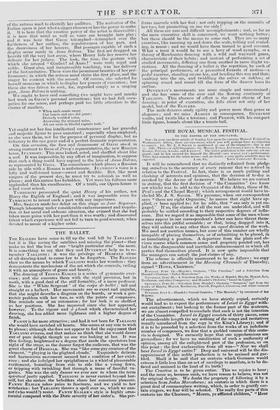THE BALLET.
THE ELSLERS have come to fill up the void left by TAGLIONI : but it is like seeing the satellites and missing the planet—they make us feel the loss of our "bright particular star" the more. It is something to say that they and DUVERNAY help us to re- member TAGLIONI: it was the privilege of HEBERLE alone of all dancing-kind to cause her to be forgotten. The ELSLERS show us the means by which TAGLIONI works her wonders : they demonstrate the mechanism of the art which she conceals, veiling it with an atmosphere of grace and beauty. The (lancing of TERESA ELSLER is a series of gymnastic exer- cises; and she executes them with the rigid precision, but in sooth, with a good deal of the stiff formality, of a mere professor. She is the " White Sergeant " of the corps de ballet : tall and straight as a halbert. Her movements are so exact and angular, that she might describe a diagram on the boards, or work a geo- metric problem with her toes, as with the points of compasses. She reminds one of an automaton ; for her look is as stedfast as her positions. She has improved since she last appeared, however. To the vigour and gi plomb which characterized her dancing, she has added more lightness and a higher degree of finish.
FANNY is far more attractive; and had it not been for TAGLIONI she would have ravished all hearts. She seems at any rate to wish to please; although she does not appear to feel the enjoyment that TAGLIONI evinces, and that makes us think that she would dance out of pure delight though no one was looking at her. It was this feeling, heightened to a degree that made the spectators lose sight of the stage, as the dancer forgot the audience, that was the great charm of HEBERLE. She was "like some gay creature of the element;' "playing in the plighted clouds." Exquisitely delicate and harmonious movement seemed but a condition of her exist- ence ; and she indulged her sprightliness in a whirl of pleasurable excitement, bounding from side to side like a young fawn, or tripping with twinkling feet through a maze of fanciful va- garies. She was the only dancer we ever saw to whom the term spiritual justly applied. TAGLIONI is never carried beyond her- self, but she makes the beholders share her conscious pleasure. FANNY ELSLER takes pains to fascinate, and we yield to her witcheries: but TAGLIONI throws a spell over us, which we can- not (who would?) resist. FANNY ELSLER'S style is highly orna- Mental .compared with the Doric severity of her sister's. She per-
forms marvels with her feet ; not only tripping on the summits of her toes, but pirouetting on one toe only !
All these are rare and difficult accomplishments ; and, as far as the mere executive skill is concerned, we want nothing better; but these should be the means to some end. They are so many exercises, like running up and down the scale, trilling and multi& ing, in music ; and we would have them turned to good account. What a treat it would be to see a bevy of wood nymphs, or a throng of Bacchantes dancing with a wild and wayward grace, characteristic of their habits; and instead of performing a set of studied movements, differing one from another in mere slight.va- riations. All the dancing of a ballet is the repetition, by each of the principal performers, of a prescribed formula of motion—a pedal exercise, standing on one leg, and bending this way and that; vaulting into the air, and twiddling the calves or ankles ; or spinning round and round till the form of the dancer loses its outline.
DUVERNAY'S movements are more simple and unrestrained ; and she has some of the case and the flowing continuity of TAGLIONI. This absence of effort is the great charm of her dancing: in point of execution, she falls short not only of her model, but of the ELSLERS.
The male dancers study agility and power more than grace or elegance; and we miss ALBERT in consequence. GUERI NOT vaults, and twirls like a tetotum; and PERROT, with his compact little figure, bounds about like a tennis-ball.




















 Previous page
Previous page